What is Facial lines and wrinkles?
Ageing skin droops and develops wrinkles, lines and furrows. The severity of these changes in an individual depends on genetic tendency, skin phototype and exposure to environmental factors.
Dermatologists and cosmetic surgeons often use Glogau's classification when describing these ageing changes.
- Mild – Few wrinkles, requires little or no make-up for coverage
- Moderate – Early wrinkling, sallow complexion, requires little makeup
- Advanced – Persistent wrinkling, skin discolouration with broken blood vessels and solar keratoses, often wears make-up
- Severe – Severe wrinkling and furrows, solar keratoses, often wears make-up but it may not hide the ageing changes
The Fitzpatrick classification of facial lines refers to the degree of wrinkling around the mouth and eyes:
- Class I: Fine wrinkles
- Class II: Fine-to-moderately deep wrinkles and moderate number of lines
- Class III: Fine-to-deep wrinkles, numerous lines, and possibly redundant folds
How do facial lines and wrinkles form?
Facial lines and wrinkles (rhytides) form because of the following factors:
- Ageing processes
- Sun damage
- Muscle movement
- Gravity
- Injury
- Surgery
- Acne
- Other skin diseases with a tendency to scar (e.g. discoid lupus)
- Smoking
There is often a degree of asymmetry to the lines, as people tend to smile or frown more on one side than the other, or consistently sleep on the right or the left cheek.
Fine lines
Fine lines and wrinkles arise because of irregular thickening of the dermis and because of a decrease in the amount of water held by the epidermis. This is mainly caused by sun damage and exposure to environmental toxins particularly tobacco smoke.
Furrows
Deeper lines or furrows are classified as dynamic or static. Dynamic lines appear with movement i.e. the activity of facial muscles. Static lines are unchanged with muscle movement. Eventually dynamic lines become static.
- Crow's feet around the eyes are due to smiling and activity of the eyelid muscles (orbicularis oculi).
- Worry lines on the forehead are due to contraction of the frontalis muscle when raising the eyebrows
- Frown lines between the eyebrows are due to contraction of corrugator supercilii muscles and procerus muscle when concentrating or angry
Sags and bags
Skin laxity or drooping is caused by several factors:
- A reduction of the fat cells under the skin (subcutaneous tissue)
- Loss of collagen and elastin fibres in the dermis reducing cutaneous strength and elasticity
- Gravity, which allows the lax tissue to sag
The result is:
- Brow ptosis (the forehead sags so the eyebrows drop over the eyelids, which then feel heavy)
- Eyelid ptosis (the upper eyelid drops, sometimes obscuring the pupil)
- Baggy upper and lower eyelids
- Sagging lower eyelids, revealing the reddened mucosal surface (ectropion)
- Hollow look to the eyes
- Tired-looking eyes with a prominent groove beside the nose (tear-trough deformity)
- Jowls (loss of jaw line)
- Loss of neckline
- Elongated earlobes
- Dropping of the tip of the nose
- Thinning of the upper lip
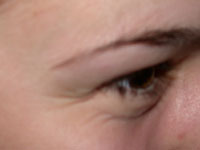 |
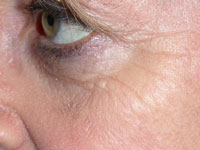 |
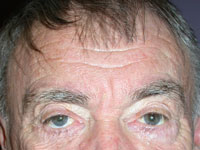 |
| Dynamic lines in smiling teenager | Static lines in 40's | Worry lines |
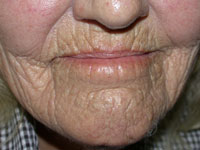 |
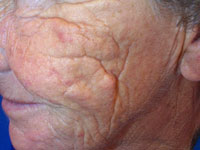 |
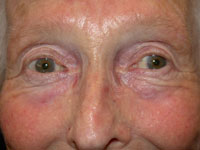 |
| Extensive perioral lines | Deep furrows | Hollow-looking eyes |
What treatment is available?
Remarkable changes in facial appearance can be obtained, giving a younger appearance and improving complexion. Often combinations of different cosmetic procedures are required for the best results.
It is most important to protect the skin from the sun life-long using sunscreens on exposed areas daily, and to avoid smoking and exposure to second-hand smoke or other pollutants.
Moisturisers
Ageing skin feels and looks better when moisturisers are applied regularly. These improve the water-holding capacity of the skin. Choose one that feels nice to apply, doesn't sting or burn or provoke acne.
- Use tepid or warm tap water and a non-soap cleanser to wash your face twice daily.
- If you will be outdoors even briefly, include UV-protection as part of your morning regime.
Anti-ageing formulas
Many face creams may include so-called anti-ageing ingredients. These may include anti-oxidants and/or exfoliants including:
- Topical retinoids
- Vitamin c
- Alpha hydroxy acids
- Polypeptides
- Various plant extracts
With the exception of the topical retinoids, the effectiveness of many of these anti-ageing ingedients is unproven.
Resurfacing
Resurfacing refers to various techniques in which the top layers of the epidermis are peeled off using chemical or mechanical means. Peels may even out pigmentation and improve skin texture. They can improve fine lines and static furrows but have no effect on dynamic lines.
- Superficial and medium-depth chemical peels
- Dermabrasion and microdermabrasion
- Neodynium:YAG or carbon dioxide laser resurfacing
- Non-ablative laser, intense pulsed light or thermal resurfacing including thermage
Implantation
Individual lines and furrows can be lifted up with implants, i.e. temporary or permanent fillers or grafts. They can also be used to improve the appearance of a thinning lip.
Botulinum toxin
Botulinum toxin is most useful for dynamic lines. It can be used to paralyse the muscles that are responsible for frown lines, crow's feet and forehead lines. It can also be used to change the shape of the eyebrows and to soften so-called smoker's lines around the lips, among other uses.
Cosmetic surgery
Cosmetic facial surgery involves repositioning facial tissues (rhytidectomy) and altering the structure of the sagging tissues.
- A facelift or mid-face lift remove excessive skin and tighten underlying muscles of the lower two thirds of the face (cheek and neck).
- A forehead or brow lift, and mid-temporal lift reduce static lines and lift up drooping eyebrows.
- Rhinoplasty may lift up the tip of the nose, reshape it or thin out excessive tissue due to rhinophyma
- Upper and/or lower blepharoplasty removes redundant skin and fat pads from the eyelids.
- Correction of platysmal bands in the neck by an open plication technique improve the appearance of a sagging neck.
